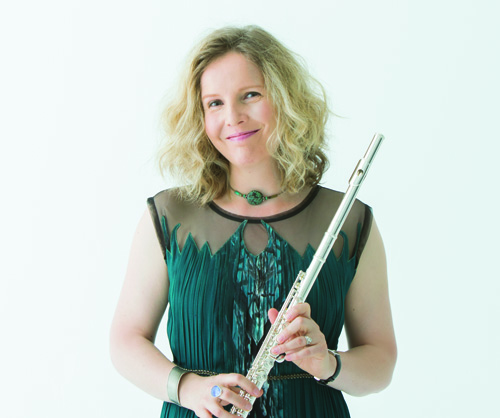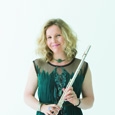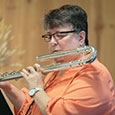
Scottish-born flutist Lorna McGhee became principal flute of the Pittsburgh Symphony Orchestra in 2012 and is an Artist Lecturer at Carnegie Mellon University. Known for her luscious tone colors and dynamics McGhee has also performed as a soloist and guest principal with orchestras in the United Kingdom and North America.
What do enjoy about playing with the Pittsburgh Symphony?
The Pittsburgh Symphony is such a tradition and so established here – it is truly a culture. When I first came to Pittsburgh, I remembered being blown away. I recall a conversation with a taxi driver who was a Mahler fanatic. When we were looking for our house, people working in the real estate office spoke of their love for the Symphony.
PSO is a great symphony orchestra and that drew me to move to Pittsburgh. I love the spirit of the orchestra. People really care enormously about what they are doing, about the music. It does not matter where we are playing; whether it is a kid’s concert or a runout, people play their hearts out. That is a defining characteristic of the PSO that I love.
In addition, I am very honored to be teaching at Carnegie Mellon. Fortunately, this position overlapped for one year with Jeanne Baxtresser who is someone I look up to immensely. She is a great role model and an inspiration. CMU has a beautiful flute department created together by Baxtresser and Alberto Almarza. It has been a dream to walk into their brilliantly organized vision.
Where did you grow up?
I grew up in a small coastal town called Largs, in Ayrshire on the southwest coast of Scotland. The closest big city is Glasgow, an hour’s drive inland. This part of the world is very beautiful surrounded by many islands, and the southernmost point of the mountains. A huge part of my childhood was going on long walks with my family and walking the dog on the beach.

The area around Largs is spacious and vast; the light is always changing. I would always clear my head by taking long walks whenever I had a big competition or audition.
How did you choose the flute?
I started playing the flute when I was eight years old. At that time James Galway was often on TV doing talk shows. My parents also had a recording of Peter and the Wolf, and I thought the flute was quite snazzy. So we rented a flute, and it took me about a week to make a sound on it. I was self-taught in the beginning, using A Tune A Day Book 1. I had no formal training until the fall when I was able to go to the high school each week and work with a woodwind specialist. My first teachers were a clarinetist and oboist.
When I was 11, I applied to the Royal Academy of Scotland and was accepted. I was horrified to learn that I would have to give up all my Saturdays for the hour ride to and from Glasgow and for the all-day classes. The upside was that I had the great good fortune to work with famed Scottish flutist, David Nicholson, principal flute in the Scottish Chamber Orchestra. After just a few months of working with him, I was living for Saturdays. He was one of the greatest flute teachers of our time and had studied with Geoffrey Gilbert and Jean-Pierre Rampal. When he played with the Chamber Orchestra, my ear would gravitate toward his vivid, silvery tone that was always alive and filled with sparkle. His teaching was demanding, but encouraging. When he complimented a student, it really meant something. Nicholson experienced much joy and delight in music and was able to pass that along to his students. I was fortunate to have six years with him.
Where did you do your undergraduate and graduate training?
After high school I went to the Royal Academy in London and began working with William Bennett. I studied four years there, three as an undergraduate and one post-grad. I also studied with his wife, Michie Bennett, for technique and fundamentals. My favorite, most memorable lessons with WIBB were on Marcel Moyse’s Tone Development Through Interpretation and 24 Little Melodies with Variations. He would teach students how to develop the speed of the vibrato through a line to give the notes of most importance the fastest vibrato. The other side of this would be to de-emphasize less important notes or resolutions with less vibrato. For example in the First Easy Melodic Study, he would sing “Oh how I LOVE you” with the first phrase. He would develop the vibrato through the first three notes (Oh How I ), then show the appoggiatura with the fastest vibrato on the fourth note (LOVE), and then have slower vibrato on the fifth note (you) since it was the resolution of the appoggiatura. The other essential element was accurately playing repeated notes by diminishing the first note ever so slightly, and then with the reiteration of the same note, articulating with more vibrato to show the emphasis and repetition. In a big hall, he would say that without that attention to detail, the repeated note would not register. It would just sound like mush, or at worst, a tie. In other words, the player should diminish (vibrato and volume) at the very last minute on the I and really vibrate on the downbeat (LOVE). This is what good string players do as well. Players should build phrases in this way – developing this idea even more in the second phrase. In the third phrase, modify the amount of diminishment (on you) as the phrase goes on and keep the energy going through the phrase.
This teaches players to become flexible in sound and articulation. It is learning syntax, grammar, punctuation, and diction so you can talk through your instrument. It is not enough to play with a nice tone and nice vibrato; you have to respect inflection, tension and resolution, and reflect everything in the energy of the sound. Vibrato is really energy, and the energy modulates. Sound is never static; it is always in motion. This is how you turn sound or noise into meaning and tell a story and engage the audience. When I look back on these years, I feel incredibly lucky because everyone was so supportive and positive. It was about making the music come alive and never just a matter of sheer execution.
What was your first playing job after college?
I actually missed graduation because I had a gig. David Nicholson had spoken to me candidly as I was auditioning for college. He cautioned me against going into music as a career, as he would caution his own children. (Ironically, his own daughter became an actress, and his son is a French horn player.) I did appreciate this bit of wisdom. It made me understand the gravity of practicing and preparing. If I could go back now and caution my 18 year-old self, it would be to practice intelligently and fully, but not obsessively, and beyond endurance. I was overly anxious about getting a job. So, I never turned down a gig and missed my graduation.
My first professional position, at age 22, was as co-principal flute with the BBC Orchestra. This was after a two-year trial. After the BBC, I met my husband David Harding, who is a viola player, at a chamber music festival. At that time he was with a string quartet at the Indiana University South Bend campus. I got a one-year position to teach flute at the University of Michigan (for which I was too young). After that David took a job in Vancouver, Canada, teaching at the University of British Colombia, and I ended up as the adjunct flute teacher there, as well.
While we were in Vancouver, I became temporarily disheartened about music as a career. The business of music was too much for me. It did not match my expectations and ideals. I started a new master’s degree at Simon Fraser University in Vancouver in graduate liberal studies including literature, comparative religions, political science, and philosophy. I encourage my students to understand their choice about playing. It is always a choice, we are under no compulsion to play. We are not bound to this, life is much bigger; this is just one aspect of self. It is a beautiful part, and even a main part, but we are more than our music. I decided to come back to music and never give up on my ideals, and that is when I auditioned for the principal flute position in Pittsburgh.
What do your daily practices include?
The goal is to have such a great technique that you can do anything musically, without even having to think about it. Therefore, most of my practice is pure technique and building kinesthetic memory and effortlessness. I practice tone and flexibility exercises ad infinitum and do a lot of singing and playing of long tones to open up resonance and free up my breathing. I practice harmonics everyday (slurred), lifting the airstream like a searchlight as I go through the registers (moving the airstream up and down by moving the bottom lip and corners forward or back). You can experience this without the flute by blowing onto your hand with a flute embouchure and them moving the airstream up and down your hand. Think of it as moving from the bottom register (base of the hand) to the high notes (at your fingertips). Imagine that the airstream is a beam of light that can illuminate the sound through all of the registers. With a great technique (and the greatest aspect of technique is tone production), you will have the confidence to open up your peripheral awareness. For example, when I play Dvo˘rák’s New World Symphony, I want to be aware of the essence of what the cellos are saying in their beautiful opening phrase and respond to it emotionally with my own answer, just as an actor would respond to the essence or meaning of the what a fellow actor has just said. This is very different expressively than merely saying the lines, or playing your part on cue – no matter how beautifully you have prepared it. Music is a living, breathing art form. It is not wooden and should be responsive, alive, vital. When you take the time to develop an impeccable technique, you can really focus on making the music come alive.
Igniting the Breath
The composer Reynaldo Hahn, best known for his Art Songs once wrote that of the myriad approaches to supporting the sound, he felt the best philosophy was to support with the heart. Similarly, in the book Vocal Wisdom: Maxims of Giovanni Battista Lamperti, Lamperti talks about igniting the breath with the desire to communicate. Legendary Chicago Symphony tuba player Arnold Jacobs talked about uniting the expressive drive (the song) with the dynamic and living air stream (the wind).
Flutists are artists of the breath. Phrasing is more than just crafting a line, it is imbuing sound with life and meaning. Flutists do that fundamentally through the breath – accept no substitutes. Really commit to what you want to say and put it right into the airstream. As Jacobs said, let the air lead, and the muscles follow. If you let the muscles lead (i.e. tightening the muscles around your ribs, or throat, or diaphragm too much), you will be in an antagonistic relationship to the breath where you have to push and pull the airstream. This greatly limits expression.
Think of the airstream as having the dynamic energy of a river or the waves of the sea. Try not to dam the river with too much muscle tension as this will cause the sound to be static and even stagnant. It is important to recognize that the goal is not relaxation. Far from it. The airstream should be alive and dynamic and pretty fast. Do not cage in the breath or the sound with excess muscle tension. Release the breath. The better you release it, the more easily it will return.
This takes quite a lot of courage as flutists are often afraid of running out of breath. However, take the risk and see what happens. Over time you can build up a wonderful elasticity with the breath, and that gives a lot of freedom of expression. One of the exercises I do at the beginning of my warmup to invite this free exchange of the in-breath and out-breath is singing and playing long tones at the same time. Allow the air to flow effortlessly back into the body after releasing the sung out-breath with great freedom. Try to stay out of your own way and just observe. An effortless in-breath starts with breathing out really well. The key word here is to allow with no pushing, shoving, or compromising. Let the throat be an empty pipe. Singing is so natural, it helps flutists tap into the body’s intrinsic ability and cultivate the wave power of the breath.It also connects breath and voice with the flute, so that over time flutists can express themselves as directly as if they were speaking or singing – igniting the breath with meaning.
What are your thoughts on creating beautiful tone colors and dynamics?
When the body is free from any unnecessary tension, then we have the chance to become like a singer and use its resonance of the body to help us achieve expressive ideas. Quite literally you can put the expression into the airstream (speed/intensity) and if the body is like a blank slate (free from tight shoulders, locked knees, collapsed neck etc.) then the ideas come through loud and clear. Flutists can help things along by thinking about where the sound is resonating and further develop the colors by using different vowel sounds like a singer. I mean to literally make the embouchure and inside of the mouth in the shape of A, I, OO, or E. The airstream is a flutist’s medium of expression and should never be treated in a functional way as merely fuel to get from A to B. I always invite my students to be artists of the breath. That is where the spark comes from. For me the Alexander Technique is a way of helping the breath to be as free as possible, and this in turn allows the expression to be as free and direct as possible.
In the beginning, my reasons for taking Alexander lessons were very prosaic. As a student, I was practicing compulsively, my shoulders were up by my ears, and I was in pain. The Royal Academy in London offered Alexander lessons. Initially, I studied Alexander for the short-term benefits of playing without pain, but then found that my sound started to open up. I could not get enough of this. It was amazing, recognizing and making the connection that how I was using my body was having a direct result in my sound.
What is your favorite music to perform?
Anything by Debussy or Bach. My favorite collaboration is teaching and playing with William Bennett. Traveling to Japan, Canada, or the UK, and teaching with him in the summers affords me opportunities to play duets with him. I especially cherish the opportunities to play his duet arrangements of the Brahms Waltzes. I played with him at his 70th birthday party at the British Flute Society convention, and now we just celebrated his 80th birthday. Playing a Chopin nocturne or the Waltzes with him ignites a spark because there is so much warmth in his playing. I love reading his body language and getting pulled along by his phrasing.
I also enjoy playing chamber music with my husband, an amazing, sensitive viola player whose sound is just imprinted on my brain. We perform together at chamber music festivals andhave a trio (Trio Verlaine) with our friend, harpist Heidi Krutzen. She is currently principal harpist in the London Philharmonia, so we are not together frequently. I truly enjoy playing the intricate and delicate work associated with flute, harp and viola trios.
My advice to flutists everywhere is to enjoy playing, enjoy music, and pass that joy along. Pablo Casals said that playing an instrument should increase people’s confidence, not their fear.
.jpg)
Trio Verlaine
***
Recordings
Hour of Dreaming for flute and piano, Beep Records
Taheke, 20th Century Masterpieces for flute and harp, Skylark Music
Trio Verlaine: Six Departures, Ravello Records and Fin de Siècle, Skylark Music
Info about purchasing these recordings can be found at www.lornamcghee.com
***
Lorna McGhee has performed as guest principal with the Chicago Symphony, Minnesota Orchestra, Dallas Symphony, London Symphony, Academy of St-Martin-in-the-Fields, and Chamber Orchestra of Europe. Before coming to North America in 1998, she was co-principal flute of the BBC Symphony Orchestra, England. As a soloist, she has performed with the London Symphony Orchestra, Scottish Chamber Orchestra, BBC Scottish Symphony Orchestra, Manitoba Chamber Orchestra, Toronto Philharmonia, Victoria Symphony, the Nashville Chamber Orchestra, Oregon Bach Festival Orchestra, San Luis Obispo Symphony and Pittsburgh Symphony Orchestra.
In addition to her current position at Carnegie Mellon University, she previously taught at the University of Michigan and the University of British Columbia. She has given masterclasses at universities, conservatoires, including Juilliard School and the Royal Academy of Music, and flute festivals in the UK, USA, Japan, Taiwan, Australia and Canada, She teaches at summer schools, including the Pender Island Flute Retreat, the William Bennett International Summer School, and the Galway Flute Festival. McGhee studied with David Nicholson in Scotland and with Michie and William Bennett at the Royal Academy of Music, London.
***






